Intel Rocket Lake (14nm) Review: Core i9-11900K, Core i7-11700K, and Core i5-11600K
by Dr. Ian Cutress on March 30, 2021 10:03 AM EST- Posted in
- CPUs
- Intel
- LGA1200
- 11th Gen
- Rocket Lake
- Z590
- B560
- Core i9-11900K
Gaming Tests: Final Fantasy XV
Upon arriving to PC, Final Fantasy XV: Windows Edition was given a graphical overhaul as it was ported over from console. As a fantasy RPG with a long history, the fruits of Square-Enix’s successful partnership with NVIDIA are on display. The game uses the internal Luminous Engine, and as with other Final Fantasy games, pushes the imagination of what we can do with the hardware underneath us. To that end, FFXV was one of the first games to promote the use of ‘video game landscape photography’, due in part to the extensive detail even at long range but also with the integration of NVIDIA’s Ansel software, that allowed for super-resolution imagery and post-processing effects to be applied.
In preparation for the launch of the game, Square Enix opted to release a standalone benchmark. Using the Final Fantasy XV standalone benchmark gives us a lengthy standardized sequence to record, although it should be noted that its heavy use of NVIDIA technology means that the Maximum setting has problems - it renders items off screen. To get around this, we use the standard preset which does not have these issues. We use the following settings:
- 720p Standard, 1080p Standard, 4K Standard, 8K Standard
For automation, the title accepts command line inputs for both resolution and settings, and then auto-quits when finished. As with the other benchmarks, we do as many runs until 10 minutes per resolution/setting combination has passed, and then take averages. Realistically, because of the length of this test, this equates to two runs per setting.
| AnandTech | Low Resolution Low Quality |
Medium Resolution Low Quality |
High Resolution Low Quality |
Medium Resolution Max Quality |
| Average FPS | 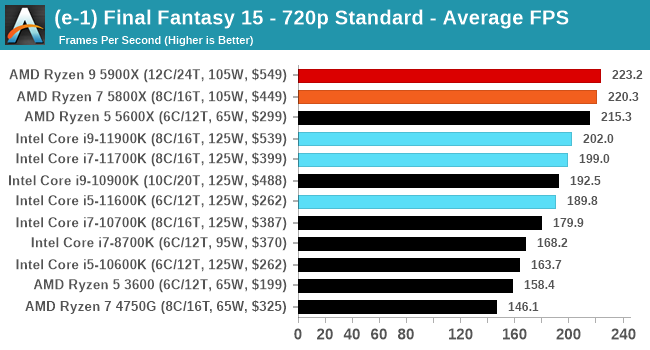 |
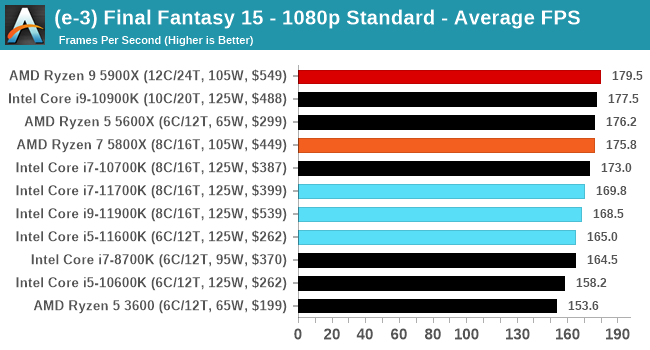 |
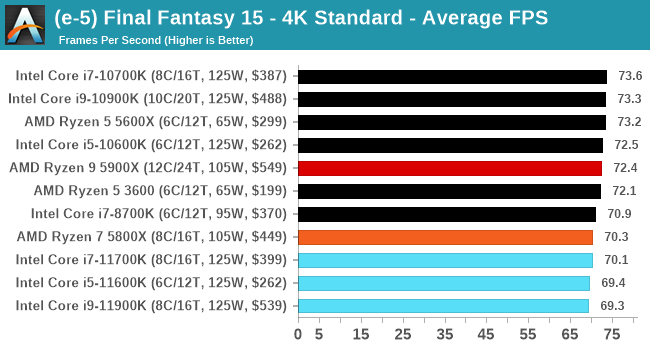 |
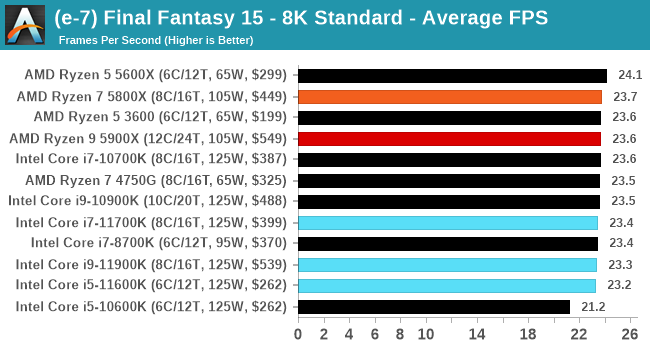 |
| 95th Percentile | 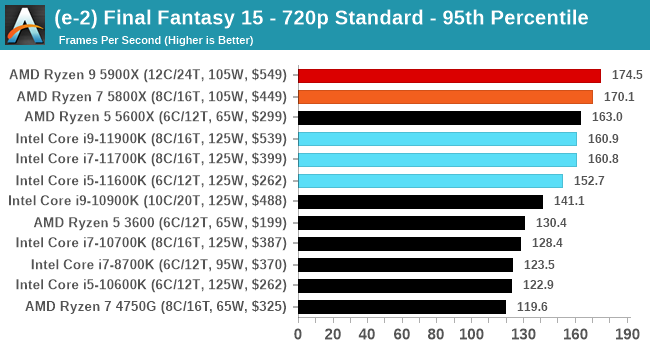 |
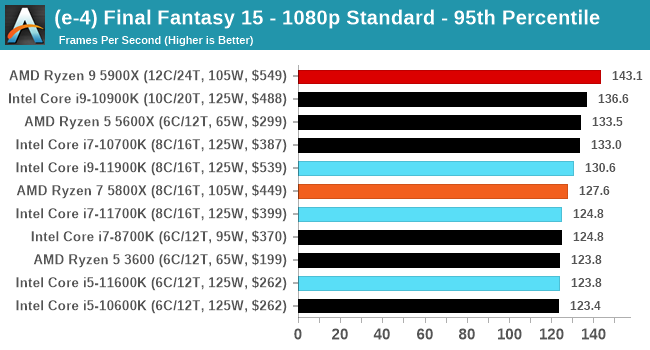 |
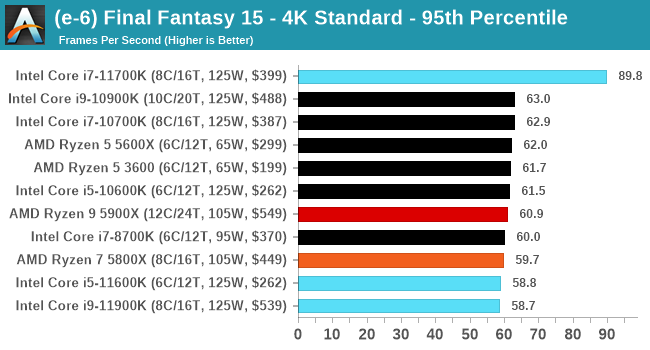 |
 |
All of our benchmark results can also be found in our benchmark engine, Bench.












279 Comments
View All Comments
SystemsBuilder - Tuesday, March 30, 2021 - link
Honestly, I think they just mislabeled the 11900k and 11700k in the first 3D Particle Movement v2.1 tests result OR it's thermal throttling because they are exactly the same but architecturally (11900k higher frequencies).But the whole topic of AVX512 is interesting. It looks like Intel did not release Cypress Cove AVX-512 architecture details like they did for Sunny Cove last year (and Skylake-X cores before). But if Cypress Cove is close enough to Sunny Cove (and tit should be), they have crippled the AVX-512 quite severely but to confirm that we need to see the official Intel slides on core design. I am specifically talking about that core port 5 is crippled in Sunny Cove (compared to what Skylake-X and Cascade lake-X have) and does not include a FMA, essentially cutting the throughput in half for FP32 and FP64 workloads. Port 5 do have a ALU so Integer workloads should be running at 100% compared to Skylake-X. I really like to see Cypress Cove AVX-512 back end architecture design at the port level from Intel to understand this better though.
GeoffreyA - Tuesday, March 30, 2021 - link
I believe they added an FMA to Port 5, and combining that one and the FMA from Port 0, create a single AVX512 "port," or rather the high- and low-order bits are dispatched to 5 and 0.https://www.anandtech.com/show/14514/examining-int...
https://en.wikichip.org/w/images/thumb/2/2d/sunny_...
GeoffreyA - Tuesday, March 30, 2021 - link
I'm not fully sure but think Cypress is just Willow, which in turn was just Sunny, with changes to cache. Truly, the Coves are getting cryptic, and intentionally so.SystemsBuilder - Tuesday, March 30, 2021 - link
The official intel slide posted on this page: https://www.anandtech.com/show/14514/examining-int... (specifically this slide: https://images.anandtech.com/doci/14514/BackEnd.jp... , shows what i'm talking about. The 2nd FMA is missing on port 5 but the ALU is there - 50% of FP compute power vs. Skylake-X architecture. The other slide on wikichip is contradicting official intel slide OR it only applies to server side with full Sunny Cove enabled (usually the consumer client side version is a cut down).In any case these slides are not Cypress Cove so the question remains what have they done to AVX-512 architecture port 0+1 and port 5.
GeoffreyA - Tuesday, March 30, 2021 - link
You're right. I didn't actually look at the Intel slide but was basing it more on the Wikichip diagram and Ian's text. Will be interesting if we can find that information on Cypress C.JayNor - Tuesday, March 30, 2021 - link
"My main interest is getting the fastest single-core AVX available..."Rumors within the last week say there will be Emerald Rapids HEDT chips next yr. Not sure about Ice Lake Server workstation chips. If either of these provide dual avx512 they might be worth the wait.
SystemsBuilder - Tuesday, March 30, 2021 - link
I'm thinking Sapphire Rapids, which is due to arrive in late 2021 (very best case or, more likely, 2022), is the one to hold out for. Build on the better performing 10nm Finfet, it will add PCIe 5.0, DDR5 and further improve on AVX 512 with BF16 and AMX Advanced Matrix Extensions https://fuse.wikichip.org/news/3600/the-x86-advanc...Now, if you read about this you realize what step up for (FP and int) compute that is. Massive!
scan80269 - Tuesday, March 30, 2021 - link
It looks like Rocket Lake is the first desktop class x86 processor to support hardware acceleration for AV1 video format decode, similar to Tiger Lake for mobile. Interesting how this power hungry processor family can deliver good energy efficiency when it comes to watching 4K HDR movies/videos. OTT platform providers need to offer more content encoded in AV1, though.Hifihedgehog - Tuesday, March 30, 2021 - link
Meh... This is a fixed-function IP block for a very specific task so it is going to be low power. At this point, for most people, HEVC support is what actually matters. HEVC already offers a 50% improvement in bitrate efficiency over H.264, and AV1 only claims the same thing. Royalties or not, because HEVC was first to the game, it became the industry standard for UHD/4K Blu-ray. Timing is everything and AV1 missed the boat on that by about five years. So with the industry locked into HEVC, AV1 is going to have an incredibly hard time getting uptake outside of online streaming, which is a whole other ball of wax. And even then, as a content creator, you can use HEVC royalty free anyway if you are livestreaming on YouTube.GeoffreyA - Tuesday, March 30, 2021 - link
While AV1's quality is excellent, surpassing that of HEVC, its encoding speed is impractical for most people,* and I'm doubtful whether it's going to get much better. If people (and pirates, yes) can't use it easily, its spread will be limited. The only advantage it has, which I can vouch for anecdotally, is superior quality to HEVC. But even this advantage will be short lived, once VVC enters the fray in the form of x266. I've got no idea how x266 will perform, but from testing the Fraunhofer encoder, saw that VVC and AV1 are in the same class, VVC being slightly ahead, sharper, and faster.* libaom, the reference encoder. Intel's SVT-AV1 is faster but has terrible quality.